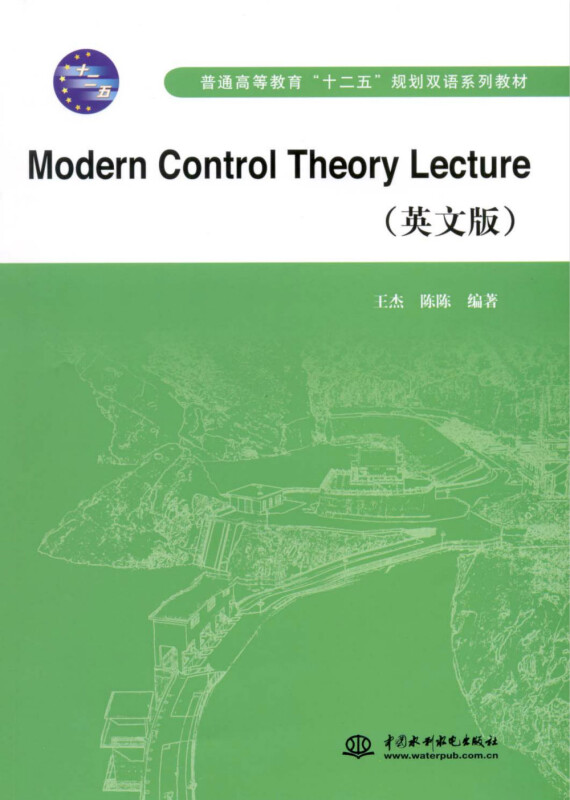暂无评论
图文详情
- ISBN:9787508484211
- 装帧:一般胶版纸
- 册数:暂无
- 重量:暂无
- 开本:16
- 页数:220
- 出版时间:2017-08-02
- 条形码:9787508484211 ; 978-7-5084-8421-1
内容简介
本书将现代控制理论方法与电力工程实践紧密结合,主要介绍了控制系统的状态空间表达式、控制系统状态空间表达式的解、线性系统的能控性与能观性、稳定性与Lyapunov方法、线性定常系统的综合、*优控制等。 本书既可作为高等学校电气工程与自动化专业学生、教师的教学用书,也可作为从事相关专业技术研究人员的参考用书。
目录
Introduction
O.1 Development of control theory
0.2 Structural requirements and control features of thesystem
0.3 Nonlinear control in power system
0.4 The main content of modern control ll~eory
Chapter 1 State-space expression of control system
1. 1 The basic concepts
1.2 The simulation structure diagram of state:spaceexpression
1.3 The construction of state-space expression
1.4 The construction of state-space expression from transferfunction
1.5 Transfer function and transfer function matrix fromtransfer function to state e
1.6 State-space expression of composite system
1.7 Linear transformation
1.8 State-space expression of discrete system
Exercise
Chapter 2 The solution of state-space expression of controlsystem
2.1 Solution of homogeneous state equation of lineartime-invariant system
2.2 Matrix exponent
2.3 Homogeneous solution of time-varying system
2.4 State transfer matrix
2.5 Solution of linear continuous system non-homogeneousstate equation
2.6 Solution of discrete-time system state equation
2.7 Discretization of continuous time-state-spaceexpression
Exercise
Chapter 3 Controllability and observability of linearsystem
3.1 Controllability of time-invariant discrete system
3.2 Controllability of time-invariable continuoussystem
?3.3 Observability of time-invariant system
3.4 Controllability and observability of linear time-varyingsystem
3.5 The dual relation of controllability andobservability
3.6 Structural decomposition of linear time-invariantsystem
3.7 Relation of controllability, observability and transferfunction matrix
3.8 Controllability standard and observabilitystandard
3.9 System realization
Exercise
Chapter 4 Stability and Lyapnnov method
4.1 The basic concept of stability
4.2 The basic idea of Lyapunov function
4.3 Lyapunov function stability method
4.4 Asymptotic stability
4.5 Some common construction method of Lyapunovfunction
4.6 Vector Lyapunov function
4.7 Application of Lyapunov methods in linear system
4.8 Lyapunov method in Hamilton system
Exercise
Chapter 5 Synthesis of linear time-invariant system
5.1 Definition and property of state feedback
5.2 Pole assignment
5.3 System stabilization problem
5.4 System decoupling problem
5.5 State observer
Exercise
Chapter 6 Optimal control
6.1 Summary
6.2 Variational methods of solving optimal control
6.3 Hamilton function
6.4 Phorcha problem
6.5 Minimum principle
6.6 Dynamic programming
6.7 Linear quadratic optimal control problem
Exercise
O.1 Development of control theory
0.2 Structural requirements and control features of thesystem
0.3 Nonlinear control in power system
0.4 The main content of modern control ll~eory
Chapter 1 State-space expression of control system
1. 1 The basic concepts
1.2 The simulation structure diagram of state:spaceexpression
1.3 The construction of state-space expression
1.4 The construction of state-space expression from transferfunction
1.5 Transfer function and transfer function matrix fromtransfer function to state e
1.6 State-space expression of composite system
1.7 Linear transformation
1.8 State-space expression of discrete system
Exercise
Chapter 2 The solution of state-space expression of controlsystem
2.1 Solution of homogeneous state equation of lineartime-invariant system
2.2 Matrix exponent
2.3 Homogeneous solution of time-varying system
2.4 State transfer matrix
2.5 Solution of linear continuous system non-homogeneousstate equation
2.6 Solution of discrete-time system state equation
2.7 Discretization of continuous time-state-spaceexpression
Exercise
Chapter 3 Controllability and observability of linearsystem
3.1 Controllability of time-invariant discrete system
3.2 Controllability of time-invariable continuoussystem
?3.3 Observability of time-invariant system
3.4 Controllability and observability of linear time-varyingsystem
3.5 The dual relation of controllability andobservability
3.6 Structural decomposition of linear time-invariantsystem
3.7 Relation of controllability, observability and transferfunction matrix
3.8 Controllability standard and observabilitystandard
3.9 System realization
Exercise
Chapter 4 Stability and Lyapnnov method
4.1 The basic concept of stability
4.2 The basic idea of Lyapunov function
4.3 Lyapunov function stability method
4.4 Asymptotic stability
4.5 Some common construction method of Lyapunovfunction
4.6 Vector Lyapunov function
4.7 Application of Lyapunov methods in linear system
4.8 Lyapunov method in Hamilton system
Exercise
Chapter 5 Synthesis of linear time-invariant system
5.1 Definition and property of state feedback
5.2 Pole assignment
5.3 System stabilization problem
5.4 System decoupling problem
5.5 State observer
Exercise
Chapter 6 Optimal control
6.1 Summary
6.2 Variational methods of solving optimal control
6.3 Hamilton function
6.4 Phorcha problem
6.5 Minimum principle
6.6 Dynamic programming
6.7 Linear quadratic optimal control problem
Exercise
展开全部
本类五星书
本类畅销
-

勒维特之星-大发现系列丛书
¥4.0¥16.0 -

喜马拉雅山珍稀鸟类图鉴
¥27.2¥68.0 -

昆虫的生存之道
¥12.2¥38.0 -

昆虫采集制作及主要目科简易识别手册
¥15.0¥50.0 -

古文诗词中的地球与环境事件
¥8.7¥28.0 -

声音简史
¥21.3¥52.0 -

不匹配的一对:动物王国的性别文化
¥16.7¥42.8 -

物理学之美-插图珍藏版
¥20.7¥69.0 -

现代物理学的概念和理论
¥18.4¥68.0 -

技术史入门
¥14.4¥48.0 -

几何原本
¥35.6¥93.6 -

改变世界的发现
¥15.4¥48.0 -

图说相对论(32开平装)
¥13.8¥46.0 -

数学的魅力;初等数学概念演绎
¥7.7¥22.0 -

星空探奇
¥14.0¥39.0 -

宇宙与人
¥10.5¥35.0 -

数学专题讲座
¥13.3¥29.0 -

袁隆平口述自传
¥19.9¥51.0 -

为了人人晓得相对论
¥3.9¥13.5 -

一代神话:哥本哈根学派
¥8.1¥15.5













